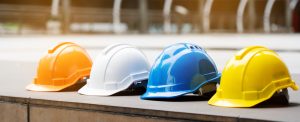How can you ensure safety when Working at Heights?
Falls from heights is one of the most widespread injuries causing worker death, alarmingly being the third most common cause of fatality incidents in Australia for 2021 1. Falls from heights are most severe in the construction industry, where it is the leading cause of traumatic injuries and fatalities in NSW alone2.

Unfortunately working at heights is an integral part of work for most construction and building industry employees. Therefore it is vital that businesses in these industries have a systematic process in place to manage and control the risks of falls so far as reasonably practicable.

Working at heights is an integral task of construction and need to be managed meticulously
Below are some practical information for employers to help manage the risks of falls from heights in their workplace.
Where do I start when managing the risk of falls?
The first thing to do when managing the risk of falls, is to identify hazards and assess the risk involved in the work to be carried out.
In construction, all work where there is a risk of a person falling more than 2 metres is classified as high risk construction work and requires a Safe Work Method Statement (SWMS) before work can proceed. The SWMS document is a very useful systematic tool for identifying and evaluating site specific risks. It involves the identification of all possible hazards involved in the work to be carried out, allocating a risk rating for each hazard (i.e. how likely that hazard will occur) and sets out specific control measures that all workers must follow to ensure the work is being performed safely.

A SWMS must be created in consultation with all workers involved who will be performing the high risk work. A responsible person (usually the site manager) is ultimately responsible for ensuring that all workers follow the controls set out in the SWMS, including all sub-contractors and service providers involved.
What can be classified as a fall hazard?
A fall hazard is described as a situation where a worker is exposed to a risk of fall from one level to another that is reasonably likely to cause an injury. Note that even falls from a low height have the potential to cause a serious injury.
Situations where there are risk of falls include activities where a person is working:
- Off the ground – such as up on ladders and on elevated work platforms
- On the ground close to holes (such as near excavations), edges or ledges (such as on retaining walls)
- Near openings and holes where people could fall through (such as skylights)
- In areas where objects may fall from higher levels and cause injury

Uncovered excavation and trenches can pose a falls hazard to workers
Eliminating risks before commencing work
Employers should apply the hierarchy of control when managing workplace hazards. Elimination of the risk of falls from heights should be done as much as possible in the design stage before any work is carried out.
Where possible plan activities so that work can be done from the ground or at ground level, which involve thinking outside the box and doing things differently. Ways of doing work on the ground instead of from heights include:
- Workers at ground level using tools with extendable handles to reach up (such as telescopic handles for painting or pruning)
- Prefabrication of roofs, wall frames and trusses at ground level
- Construction of walls using tilt up concrete panels

Using tilt up concrete panels made offsite reduces the risk of working at heights onsite
The next step: substitute with a safer surface
Where work is not able to be carried out from the ground or from a solid construction, adequate protection against the risk of falls must be provided. Examples include:
- Physical barriers or fall restraints around all perimeters and any openings, generally consisting of a top-rail at least 900mm above the working surface, a mid-rail and a toe board
- Providing edge protection
- Temporary elevated work platforms or scaffolds
- Even and accessible work surfaces and slopes
- Safe entry and exit points

A scaffold is a safe surface when working at heights
Ensure that openings such as holes in floors are fenced off with secure barriers or covered over with safety mesh or timber sheeting.
What else can be done to manage working at heights?
Where a safer surface cannot be provided, engineering controls can be utilised which include:
- A ‘work positioning’ system where the worker is restrained and prevented from reaching an unguarded edge. These consists of a lanyard, a lifeline or a safety harness.
- A fall arrest system to prevent or reduce the severity of injury if a fall does occur. Examples include catch platforms, industrial safety nets, a lifeline, harness and rope grabs
Personal Protective Equipment
Individual fall arrest systems are classified as Personal Protective Equipment (PPE) and includes lanyard, a lifeline or a safety harness. PPE should be used only when other means of providing fall protection (such as scaffold, guardrails and elevated work platforms) have been considered and are not practicable.

Getting your workers onboard to work safely
Worker consultation is crucial during the start of the project, to allow sharing of information, giving workers reasonable opportunity to express views and participate in decision making about health and safety matters which will assist in reducing work related injuries.
You must ensure that information, training and instructions are provided to workers exposed to potential falls from working at heights, which should include:
- The site specific hazards and risks associated with work performed at heights
- How to follow safety procedures associated with this work, including the contents of any SWMS
- The reasons fall protection measures have been put in place and how to use them correctly
- The proper use, wearing, storage and maintenance of PPE
- Information and training of procedures for emergency and rescue

Employers have responsibilities under work health and safety laws to ensure that falls hazards in the workplace are managed and controlled, especially in the construction industry where working at heights is inherent. Safe working at heights requires thinking outside the box, as well as putting processes in place which can be rigorous and does not come naturally. But all these efforts should be priceless if we remember that worker injuries should never be a cost of doing business.
Citations
- Safe Work Australia, “Key WHS Statistics Australia 2021”, safeworkaustralia.gov.au, accessed 24 Feb 2022.
- SafeWork NSW, “Incident Information Releases – Construction”, safework.nsw.gov.au, accessed 24 February 2022.











